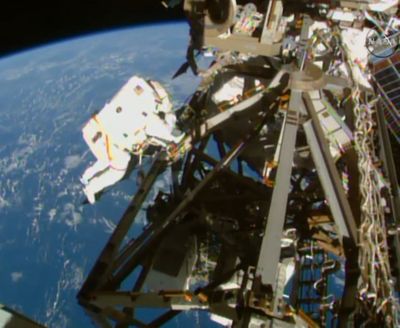Astronauts finish cable installation on space station
ISS being readied to accommodate new spacecraft

CAPE CANAVERAL, Fla. – Spacewalking astronauts successfully completed a three-day cable job outside the International Space Station on Sunday, routing several-hundred feet of power and data lines for new crew capsules commissioned by NASA.
It was the third spacewalk in just over a week for Americans Terry Virts and Butch Wilmore, and the quickest succession of spacewalks since NASA’s former shuttle days.
The advance work was needed for the manned spacecraft under development by Boeing and SpaceX. A pair of docking ports will fly up later this year, followed by the capsules themselves, with astronauts aboard, in 2017.
Once safely back inside, Virts reported a bit of water in his helmet again for the second time in as many spacewalks. He stressed it was “not a big deal” and said there was no need to hurry out of his suit.
Virts and Wilmore installed two sets of antennas Sunday, as well as 400 feet of cable for this new communication system. They unreeled 364 feet of cable on Feb. 21 and last Wednesday.
It was complicated, hand-intensive work, yet the astronauts managed to wrap up more than an hour early Sunday, for a 5 1/2-hour spacewalk. Their three outings spanned 19 hours.
“You guys have done an outstanding job,” Mission Control radioed, “even for two shuttle pilots.”
Sunday’s 260-mile-high action unfolded 50 years to the month of the world’s first spacewalk.
Soviet Alexei Leonov floated out into the vacuum of space on March 18, 1965, beating America’s first spacewalker, Gemini 4’s Edward White II, by just 2 1/2 months. Leonov is now 80; White died in the Apollo 1 fire on the launch pad in 1967.
“It’s amazing … to see how far we’ve come from the very first steps outside,” Virts said.
On Sunday – just like Wednesday – a little water got into Virts’ helmet once he was back in the air lock and the chamber was being repressurized.
Virts said it seemed to be about the same amount of water, maybe slightly more, but dried quickly. He didn’t need any towels this time when his helmet came off.
“I couldn’t feel it on my skin. I could just see the thin film on the visor,” he told Mission Control.
Engineers concluded last week it was the result of condensation during the repressurization of the air lock, and a safe and well-understood circumstance that had occurred several times before with the same spacesuit.
Virts was never in danger either day, according to NASA, and no water leaked into his helmet while he was outdoors.
Wilmore’s much newer suit functioned perfectly during the first two spacewalks, but on Sunday morning, a pressure sensor briefly malfunctioned before he floated out. A mechanical gauge, however, was operating fine. Mission Control instructed Wilmore to pay extra attention to how his suit was feeling.
Wilmore is due to return to Earth next week following a 5 1/2-month mission. Virts is midway through his expedition. Russian Soyuz spacecraft carried them both up, with NASA paying for the multimillion-dollar rides.